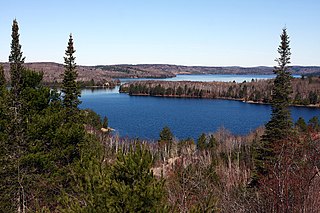
Elliot Lake is a city in Algoma District, Ontario, Canada. It is north of Lake Huron, midway between the cities of Sudbury and Sault Ste. Marie in the Northern Ontario region. Once dubbed the "uranium capital of the world," Elliot Lake has since diversified to a hub for advanced manufacturing, forest harvesting, mine reclamation expertise, retirement living, all-season tourism and remote work.
Rio Algom was a mining corporation that was purchased by Billiton in 2000 and is now part of BHP.

Uranium mining in Utah, a state of the United States, has a history going back more than 100 years. Uranium mining started as a byproduct of vanadium mining about 1900, became a byproduct of radium mining about 1910, then back to a byproduct of vanadium when the radium price fell in the 1920s. Utah saw a uranium boom in the late 1940s and early 1950s, but uranium mining declined in the 1980s. Since 2001 there has been a revival of interest in uranium mining, as a result of higher uranium prices.

Uranium ore deposits are economically recoverable concentrations of uranium within the Earth's crust. Uranium is one of the most common elements in the Earth's crust, being 40 times more common than silver and 500 times more common than gold. It can be found almost everywhere in rock, soil, rivers, and oceans. The challenge for commercial uranium extraction is to find those areas where the concentrations are adequate to form an economically viable deposit. The primary use for uranium obtained from mining is in fuel for nuclear reactors.
The Stanleigh Mine is an abandoned uranium mine located approximately 3 km northeast of Elliot Lake, Ontario, owned and operated by Rio Algom Ltd. The site has been rehabilitated and is currently undergoing environmental monitoring.
The Spanish American Mine is a historical uranium mine located approximately 11 km (7 mi) northeast of Elliot Lake, Ontario, owned and operated by Rio Algom Ltd. The site is 2.3 km (1 mi) southeast of the Denison Mine.
The Milliken Mine is an abandoned uranium mine located approximately 2.5 km northeast of Elliot Lake, Ontario, owned and operated by Rio Algom Ltd. The site has been rehabilitated and its tailings facility is currently undergoing environmental monitoring by Denison Environmental Services as part of the monitoring of the Stanleigh Mine and tailings facility.
The Panel Mine is an abandoned uranium mine located approximately 14.5 km northeast of Elliot Lake, Ontario, owned and operated by Rio Algom Ltd. The site has been rehabilitated and is currently undergoing environmental monitoring.
The Stanrock Mine is an historical uranium mine located approximately 11.5 km northeast of Elliot Lake, Ontario, owned by Denison Mines. The site has been decommissioned and rehabilitated with ongoing monitoring by Denison Environmental Services.
The Quirke Mine is an abandoned uranium mine located approximately 13.5 km north of Elliot Lake, Ontario, owned and operated by Rio Algom Ltd. The site has been rehabilitated and is currently undergoing environmental monitoring.
The Pronto Mine is an historical uranium mine located approximately 20 km south of Elliot Lake, Ontario near Spragge. The site is owned and operated by Rio Algom Ltd, has been rehabilitated and is currently undergoing environmental monitoring.

The Buckles Mine is an historical uranium mine located approximately 4.5 km southeast of Elliot Lake, Ontario, owned and operated by Rio Algom Ltd. The site has been rehabilitated. Environmental monitoring is ongoing as part of the monitoring for the nearby Nordic Mine.
The Can-Met Mine is an abandoned uranium mine located approximately 12.5 km northeast of Elliot Lake, Ontario, owned by Denison Mines Ltd. The site has been rehabilitated and its tailings facility is currently undergoing environmental monitoring by Denison Environmental Services.
The Nordic Mine, is an abandoned uranium mine in the Elliot Lake area of Ontario, owned by Rio Algom Ltd. The site has been rehabilitated and its tailings facility is currently undergoing environmental monitoring by Denison Environmental Services.
Consolidated Denison Mine, or the Denison Mine is an abandoned uranium mine located approximately 12.5 km north of Elliot Lake, Ontario. The site is bordered north by Quirke Mine and New Quirke Mine; on the east by Panel Mine and Can-Met Mine; and south by Spanish American Mine and Stanrock Mine.

Canada is the world's second-largest producer of uranium, behind Kazakhstan. In 2009, 20% of the world's primary uranium production came from mines in Canada. 14.5% of the world production came from one mine, McArthur River. Currently, the only producing area in Canada is northern Saskatchewan, although other areas have had active mines in the past.
The Agnew Lake Mine was a uranium mine located in the township of Hyman approximately 10 kilometres (6.2 mi) northeast of Agnew Lake, Ontario and 75 kilometres (47 mi) east of Elliot Lake, Ontario.

Uranium mining in the Elliot Lake area represents one of two major uranium-producing areas in Ontario, and one of seven in Canada.

Quirke Lake is body of water located in Ontario, Canada. It is located in the Quirke Lake basin, a geological basin the northern part of the Huronian Supergroup. The lake is proximate to five decommissioned uranium mines.






